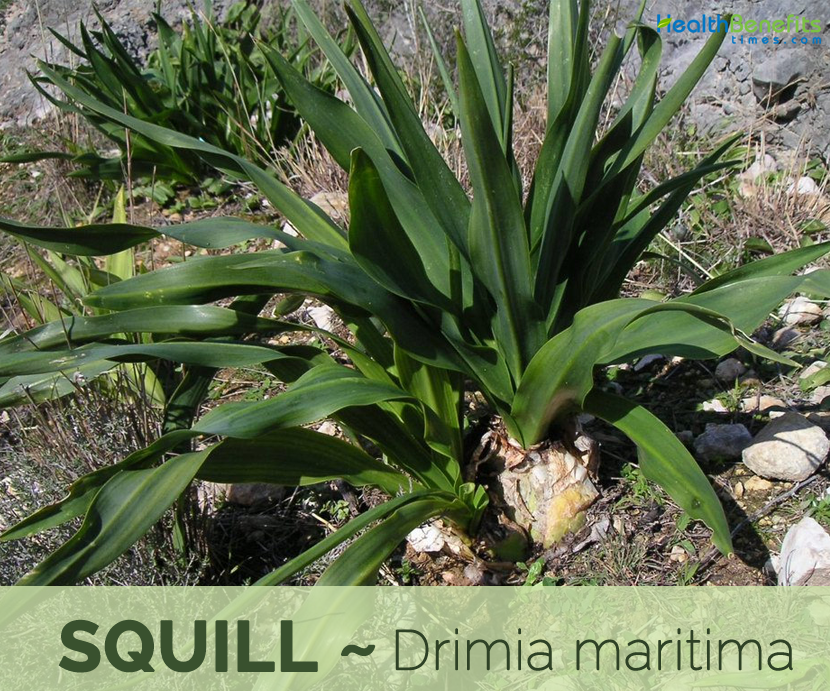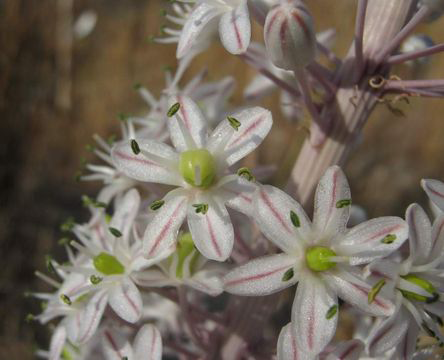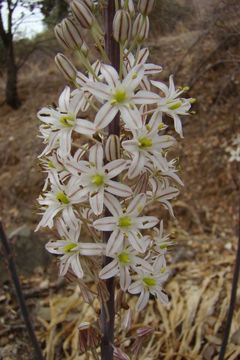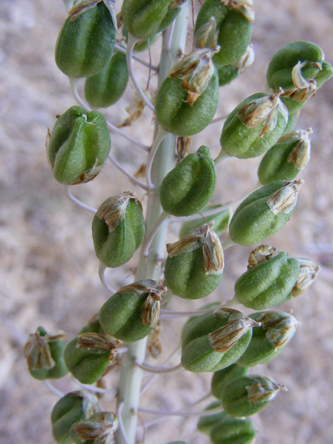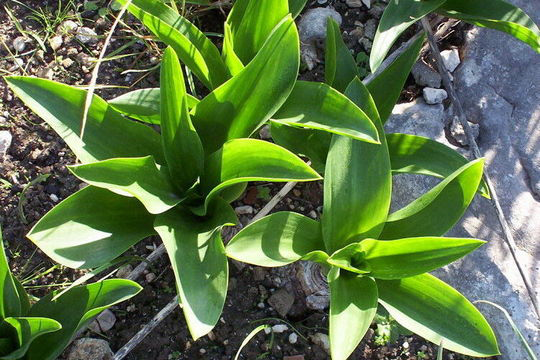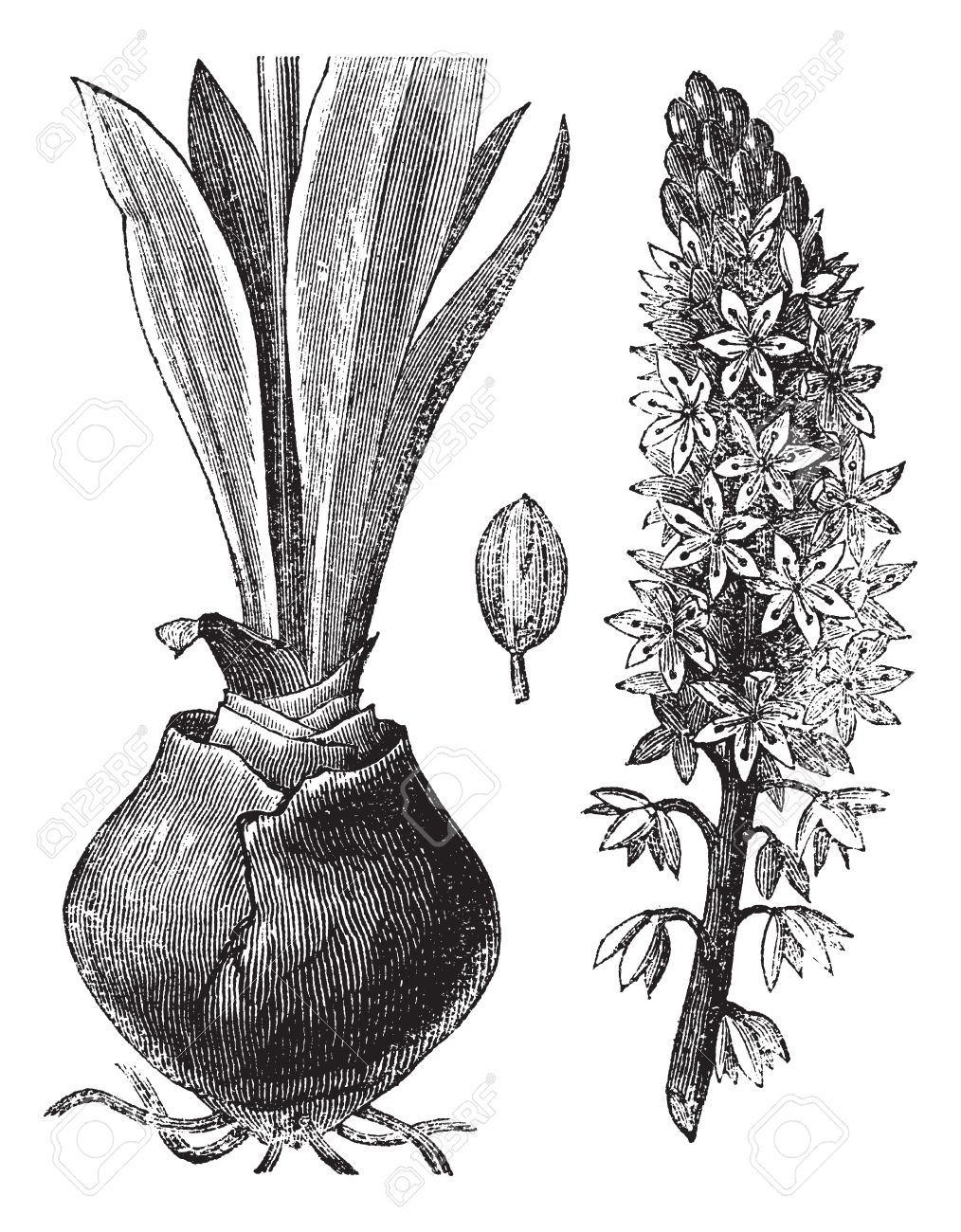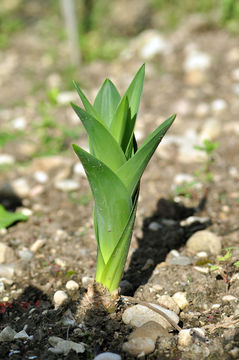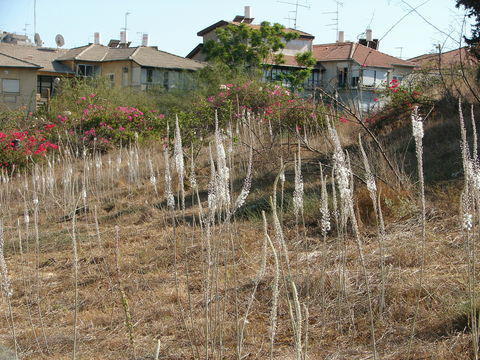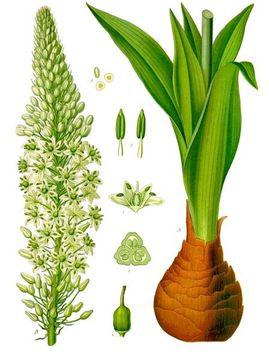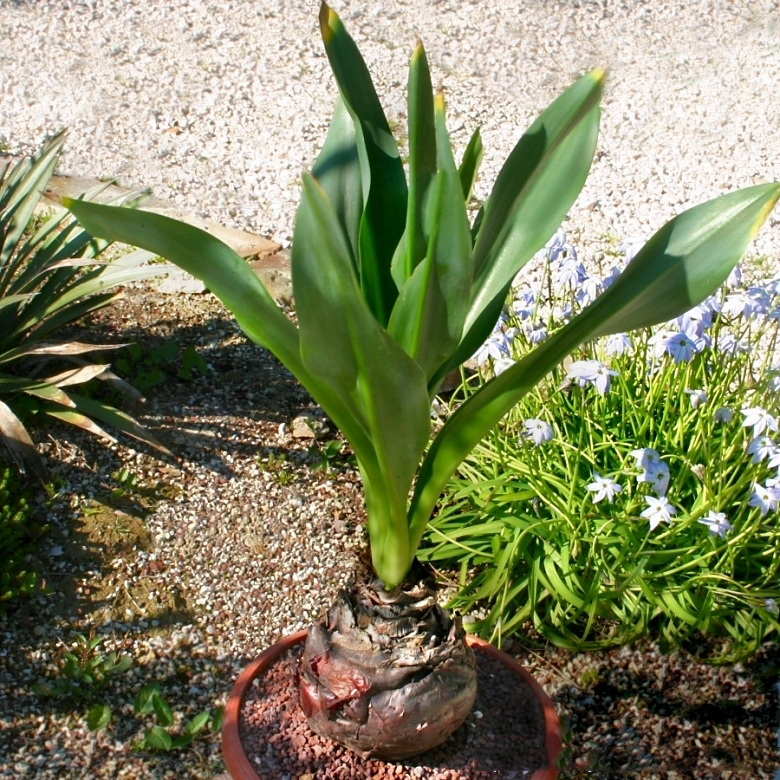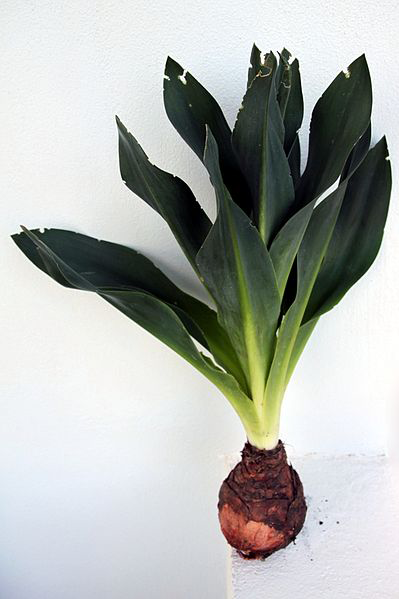Plant Description
Squill is a bulb-forming herbaceous perennial plant in the hyacinth family that grows along the open spaces in sandy or gravely soil and on limestone cliffs, often under very harsh conditions. It can grow in open and also in very shady areas. It prefers dry sandy places, especially near the seacoast. Scilla plants have a large bulb root, 15cm across, looking similar to an onion. The plant grows from a quite large, tunicated, nearly globular bulb, which can be up to 20 cm (7.9 in) wide and over five pounds in weight, the outer scales of which are thin and papery, red or orange-brown in color. Several bulbs may grow in a cluster and are usually just beneath the surface of the soil. The bulb, which is usually only half immersed in the sand, sends out several long, lanceolate, pointed, somewhat undulated, shining, dark-green leaves, measuring about (30–100 cm long) and 10 cm wide.
It has the usual structure of a bulb, being formed of smooth juicy scales, closely wrapped over one another. It has little odor, but its inner scales have a mucilaginous, bitter, acrid taste, owing to the presence of bitter glucosides. Due to the mucilaginous nature of the tissue, drying is tedious and difficult. When fresh, the bulb abounds in a viscid, very acrid juice, which is capable of causing inflammation of the skin. On drying, the bulb loses four-fifths of its weight, and its acridity is largely diminished, with slight loss of medicinal activity. The dried slices are narrow, flattish, curved, yellowish-white, or with a reddish hue, according to the variety of Squill from which they are obtained, from 1 to 2 inches long, more or less translucent.
Flower & Fruit
From the middle of the leaves, a round, smooth, succulent flower-stem rises, about 1 to 3 feet high, terminating in a long, close spike of whitish flowers, which stand on purplish peduncles, at the base of each of which is a narrow, twisted, deciduous floral leaf or bract. The flower is about 1.5 cm (0.59 in) wide and has six tepals each with a dark stripe down the middle. The tepals are white, with the exception of those on the red-flowered form. The flowers normally blossom once in several weeks and are usually one or two feet below the top of the stalk. The flowering is unique in the sense that a bunch of flowers begin to blossom at the lower end and then works upwards to the stem. The flowers are in bloom from Sep to October and are followed by oblong three-sectioned capsule up to 1.2 cm (0.47 in) long that contains black seeds, borne on an erect stalk.
Health Benefits of Squill
Squill is a bulb-forming herbaceous perennial plant in the hyacinth family that grows along the sandy coastline of the Mediterranean Sea. The compounds that make squill desirable for medicinal purposes are found in the inner layers of the bulb. It is found in remedies used to treat various lung diseases. Tonics are prepared for persons suffering with asthma, chronic bronchitis and those with whooping cough. Listed below are few of the health benefits of using squill
1. Potent Heart stimulant/cardiotonic
The bulb consists of cardiac glycosides (Scillaren A and proscillaridin) which help to stimulate the heart and produce positive inotropic and negative chronotropic effects in case of heart insufficiency, angina pectoris, nephrotic edema, and it is emetic and cathartic in higher doses.
2. Chronic bronchitis
The plant helps to stimulate bronchial mucous membrane in bronchial ailments. When compared to digitalis extract, it shows no cummulative action and acts rapidly.
3. Powerful Expectorant
Squill induces vomiting which is then headed by increase in flow of other secretions. Therefore used as an ingredient in cough medicines and is also used to treat asthma.
Traditional uses and benefits of Squill
- Bulb has been widely used by herbalists, mainly for its effect upon the heart and for its stimulating, expectorant and diuretic properties.
- Fresh bulb is slightly more active medicinally than the dried bulb, but it also contains a viscid acrid juice that can cause skin inflammations.
- It is used internally in the treatment of bronchitis, bronchitic asthma, whooping cough and oedema.
- The bulb has been used in the treatment of dandruff and seborrhea.
- It is often used in dropsy, whether due to chronic disease of the kidneys or to the renal congestion consequent to chronic cardiac disease.
- It is generally used in combination with other stimulating expectorants, its effects being thereby increased, and is considered most useful in chronic bronchitis, catarrhal affections and asthma.
- Tincture is administered combined with other expectorants, especially ipecacuanha and ammonium carbonate.
- Vinegar, Oxymel and Syrup of Squill are also common constituents of expectorant cough mixtures.
- It is also a cardiac tonic, acting in a similar manner to digitalis, slowing and strengthening the pulse, though more irritating to the gastro-intestinal mucous membrane.
- It has also been given as an emetic in whooping-cough and croup, usually combined with ipecacuanha.
- Rhizome of Squill is made into paste and applied over the area effected with skin disease and localized swelling as part of treatment.
- In condition of ascites, the fresh juice of the rhizome of Indian squill is given in a dose of 15-20 ml as part of treatment.
- Rhizome of Urginea indica is heated and the juice is extracted which is given in a dose of 15-20 ml in conditions of rhinitis and cough.
- Cold infusion of Squill is given in a dose of 40-50 ml for difficulty in micturition.
- Decoction of the rhizome of the plant is given in a dose of 30-40 ml to treat dysmenorrhea.
- Herb acts similar to digitalis leaf; hence the rhizome of the plant is given in conditions of irregular heart beat and weakened cardiac muscles.
- Decoction of Squill is given in a dose of 25-30 ml to treat intestinal worms.
- In ancient Greece, Egypt and Arabia physicians used the squill bulb as the base of an expectorant, diuretic and remedy for cough.
- It is widely used to cure unrelieved bronchitis, particularly when there is low sputum production leading to an irritating dry cough.
- Usage of squill helps in the secretion of a liquefied mucus that smoothens the progress of expectoration.
- Many herbal physicians use squill to heal bronchial asthma as well as whooping cough.
- For removing warts, a powder of the bulb should be applied locally on the affected areas.
- For Corns a poultice of the roasted bulb should be applied.
Ayurvedic Benefits of Squill
- Ascites: Take few bulbs of Squill plant and make its decoction. Drink 20 ml of it twice a day.
- Corns: Heat some root of Squill in a pan. Use them as poultice on the affected areas.
- Respiratory Diseases: Add 5 g of Jaggery in 100 ml of juice of Squill bulbs. Drink it once a day.
- Ulcers: Apply the bulb paste of Squill plant over infected areas. It helps in reducing burning sensation of skin.
- Warts: Apply the oil extracted from the shell of cashew nut over the warts and bandage the area.
Other Facts
- The plant has been used as a rodenticide and may show promise as an insecticide.
- On drying, the bulb loses four-fifths of its weight.
- Squill is not used, when the kidneys are intensely inflamed.
- It is normally collected after the base leaves have withered.
- White variety of squill that is generally used for medicinal purposes.
- Red variety of squill contains a toxic substance known as scilliroside is commercially viable.
- Pythagoras and Dioscorides hung the bulbs with sprouted leaves outside the door in spring as protection against evil spirits.
- The tall inflorescences are used as cut flowers in floristry.
Precautions
- Fresh bulb contains an acrid juice that can cause blisters when put in contact with skin.
- Bulb is poisonous in large doses.
- Red form especially has a fairly specific action on rats.
- Red bulb (Red Squill, a red variety of European Squill) is not to be consumed by humans as it’s poisonous and toxic to human health.
- Increased dose administration of the rhizome can lead to nausea, vomiting and abdominal cramps.
- Red Variety when consumed by animals, including humans, scilliroside first lead to terrible vomiting and then spreads its deadly poisonous action.
- Squill is not recommended for use in pregnant or breastfeeding women due to a lack of available scientific evidence. Squill may have abortifacient effects.
When not to Use Squill
- Seek advice from your doctor before consuming it if you are pregnant or breast-feeding.
- Do not take Squill if you are taking Digoxin (Lanoxin) without talking to your healthcare professional as both stimulate the effects of the heart and might prove dangerous.
- Do not consume Squill along with Calcium Supplements as it may stimulate the heart a little too much. Consult your health professional before taking this combination.
- Be cautious of consuming Squill if you are on a medication of Corticosteroids.
References:
https://www.itis.gov/servlet/SingleRpt/SingleRpt?search_topic=TSN&search_value=810302#null
https://npgsweb.ars-grin.gov/gringlobal/taxonomydetail.aspx?id=400663
http://www.pfaf.org/User/Plant.aspx?LatinName=Urginea+maritima
https://www.botanical.com/botanical/mgmh/s/squill86.html
http://www.theplantlist.org/tpl1.1/record/kew-305015
https://plants.usda.gov/core/profile?symbol=URMA2
https://www.herbs2000.com/herbs/herbs_squill.htm
https://en.wikipedia.org/wiki/Drimia_maritima
http://www.sciencedirect.com/science/article/pii/B9780443103445000203
http://www.naturalmedicinalherbs.net/herbs/u/urginea-maritima=sea-squill.php
http://powo.science.kew.org/taxon/urn:lsid:ipni.org:names:534538-1
https://www.ncbi.nlm.nih.gov/pubmed/27998692
Comments
| Squill Quick Facts | |
|---|---|
| Name: | Squill |
| Scientific Name: | Drimia maritima |
| Origin | Coastal regions of the Mediterranean |
| Colors | Red or orange-brown in color (Root) |
| Shapes | Large, tunicated, nearly globular bulb, which can be up to 20 cm (7.9 in) wide (Root) |
| Taste | Mucilaginous, bitter, acrid taste |
| Health benefits | Potent Heart stimulant and Powerful Expectorant |
| Name | Squill |
|---|---|
| Scientific Name | Drimia maritima |
| Native | Coastal regions of the Mediterranean and southern Europe, western Asia, and northern Africa |
| Common Names | Red squill, sea squill, sea onion, squill, ein sit, ada sogani, Scilla, European squill, white squill, Urginea squill, Mediterranean Squill, Indian squill, Scilla bulb, Drimia maritima, Drimia indica |
| Name in Other Languages | Arabic: Onsul, basal el-far, Aansalehindi, Basalefar, Basalelundal, Bsl aleunsul (basal aleunnsl, basal aleansal) (بصل العنصل (بَصَل العٌنصل، بَصَل العَنصَل),, bsl fireawn (basal fireawna), bsl alfar (basal alfara) (بصل فرعون (بَصَل فرعون)، بصل الفار (بَصَل الفار),, Eansil (eansal, busyl), ‘askil (عنصل (عَنْصَل، بُصيل)، أسكيل),, fireawna, eunsul (eunsl, eansl) (فرعون، عنصل (عُنصل، عَنصل) Basque (Euskara): Bassaquipula, Basa-kipula, Astatipula, Astakipula, Asta-tipula Bengali: Banpiaaj, Janglipiaaj, Kande Bombay: Kachinda, Kolkanada, Janglikanda, Tokesun Catalan (Català): Ceba marina, Ceba d´ase, Ceba d’ase, Scilla, Cilla, Escilla blanca, Escilla, Cebolla, Cebes marines, Ceba rotja, Ceba roja, Ceba porrina, Ceba porrera, Ceba porrassa Chinese: 海葱 English: Mededicinal squill, red squill, Sea Onion, Squill, White Squill, Hindi Squill, Crusader Spear Estonian: Meriurgiinea Finnish: Merisipuli French: Squille, Scille maritime, Scille officinale German: Meerzwiebel, Weiße Meerzwiebel Greek: Basal Fra aau, Αγιοβασιλίτσα Gujarati: Janglikanda, Ranakando Hebrew: חצב מצוי, חצב Hindi: Kolikanda, Jangli pyaz, Jangalikanela, Kanela Hungarian: Tengerihagyma Ido: Squilo Italian: Cifaglia, cipolla marina, scilla, Scilla marittima Latin: Scilla Majorcan: Ceba marina, Seba marina, Cebolla Malayalam: Kanthanga, kattulli Marathi: Janglipyajha, Rankada Persia: Piyazedashtiehindi, Piyazemoshehindi Polish: Urginia morska Portuguese: Cebola albarrâ, cila, cila maritime, Cebola-do-mar, Alvarrâ-branca, Alvarraâ marítima, Alvarraâ branca, Albarrâ-ordinária, Albarraâ marítima, Albarraâ, Scilla, Esquilla, Cebola-marinha, Cebola de rae, Cebola alvarrâ, Cebola albarraâ, Cebola albarrâ, Albarrâ-ordinária Punjabi: Kachwassal, Phaphor Russian: Morskoj luk, морской лук, Урги́нея примо́рская Slovenian: Primorska čebula Spanish: Cebolla albarrana, cebolla chirle, esquila, Esquila, Escila, Albarrana, Yerba de sabañones, Varita de San José, Caña, Bola, Biniño, Almorrana, Alhonsol, Tarabitán, Pancracio, Jabonera liria, Gamonera, Flor de perro, Farolillos, Chirle, Ceborrincha, Ceborrancho, Ceborrancha, Cebollina, Cebolletas almorraneras, Cebolleta loca, Cebolleta, Cebollas almorraneras, Cebolla albarrana, Cebolla albarrama Swedish: Sjölök Tamil: Nasivengayam Telugu: Adavithellagadda, Nakkavalligadda Turkish: Ada soğanı Upper Sorbian: Mórska česnička Urdu: Janglipiyoz Valencian: Ceba marina, Seba porrera, Seba porrina, Seba marina, Ceba porrina, Ceba porrera Walloon (walon): Agnon-d’-leu |
| Plant Growth Habit | Bulb-forming herbaceous perennial plant |
| Growing Climate | Found in open spaces in sandy or gravely soil and on limestone cliffs, often under very harsh conditions. It can grow in open and also in very shady areas |
| Soil | Dry sandy places, especially near the seacoast |
| Plant Size | Height of almost five feet (1.5m) |
| Root | Fibrous roots |
| Bulb Shape & Size | Quite large, tunicated, nearly globular bulb, which can be up to 20 cm (7.9 in) wide |
| Bulb Skin | Thin and papery |
| Bulb Weight | Over five pounds in weight |
| Bulb Color | Red or orange-brown in color |
| Leaf | Several long, lanceolate, pointed, somewhat undulated, shining, dark-green leaves, measuring about (30–100 cm long) and 10 cm wide |
| Flowering Periods | Sep to October |
| Flower | Bunch of pale or rosy flowers at the top of its 100–150 cm tall leaf-less purple-colored stem |
| Fruit | Oblong three-sectioned capsule up to 1.2 cm (0.47 in) long that contains black seeds, borne on an erect stalk |
| Flavor/Aroma | Little Odor |
| Taste | Mucilaginous, bitter, acrid taste |
| Plant Parts Used | Bulb, cut into slices, dried and powdered |
| Available Forms | Capsules and in tablet forms |
| Health benefits |
|


